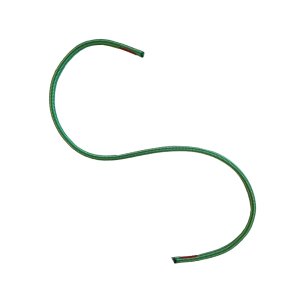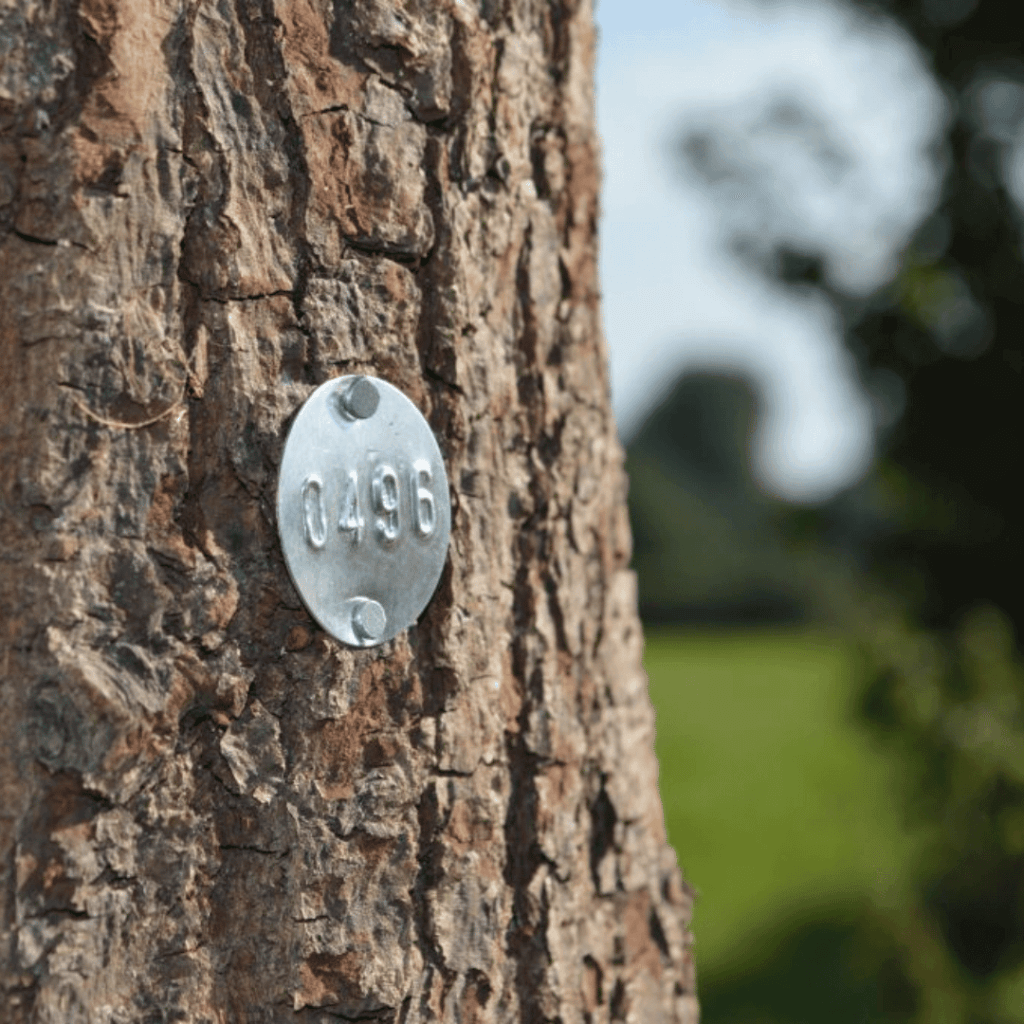
Tree Tags – unpacking the options
Introduction
The purpose of tree tags is for tree owners to be able to identify their tree stock data effectively and efficiently. This allows for easy identification, tree control and maintenance management.
There are various tree identification systems available, depending on your specific requirements – whether you’re managing a small volume of trees, or you are responsible for a large urban project, or need to keep track of cut logs and timber stock – and various other factors such as cost, longevity, customisation and more.
Below, we’ll talk you through some options of different tagging systems and the benefits of each.
Aluminium tree tags are simple, basic, and economical. This is the simplest form of tagging, requires no specific tools, and the tags can be purchased in small or large quantities. These tags are circular and have a 4-digit number stamped onto them, with a circular hole top and bottom for attachment to the tree with small nails. They are packaged sequentially in packs of 100 or 1000 tree tags (supplied with nails) and are labelled with numbers 001-100, 101-200 etc up to 9000, or in packs of 1000 numbered 0001-1000, 1001-2000 etc upwards.
Benefits of aluminium tree tags
- The aluminium tagging system is an extremely flexible system if you have inconsistent or small numbers of trees that require tagging.
- No specialist tools or equipment needed
- Cost effective for smaller volumes
- Suitable for use on various wood products

Limitations of aluminium tree tagging system
- Limited to 4 digit numbers
- Tags cannot be customised or branded
- As the tree grows, aluminium tags can quickly start to get embedded as the bark grows around them; this can lead to the tag becoming unreadable and eventually getting engulfed by the tree
- Over time, the stamped numbers can become mossy and difficult to read
- Due to being shiny the tags sometimes attract theft by squirrels, leaving gaps in the tree inventory
- This method of tree tagging can be very time consuming compared to other systems, especially on large volumes. The labour-intensive method involves carefully taking out a disc by hand and nailing it to the tree, or piece of timber.
In the overall, this is an exceptionally cost-effective solution for low volume tree tagging and can work well for companies with either occasional or variable requirements, who are looking for a simple, basic, and easy option. These aluminium tree tags also have a variety of other uses – for timber, posts, bird boxes, and more.

Latschbacher have designed several different tree tagging systems, the two most common being the ARBOtag and the Timber tag. Both tag types are extremely quick and efficient to install thanks to the cleverly designed system.
- The patented ARBOtag ‘grows with the tree’, and is specifically designed for marking living trees, with as little invasion to the tree as possible along with maximum longevity
- Latschbacher timber tags are installed using a similar method to Arbotags, but are different in design and are intended for labelling timber rather than living trees (although are sometimes used for trees).
The Latschbacher ARBOtag kit is used for the identification of trees for varying purposes and is a great solution for situations where the tagging needs to remain highly visible for years to come, and/or where a volume of trees need marking. The required equipment consists of:
- A set of Arbo tags (these are available in numerically ordered packs of 200, or packs of 1000, numbered 0001-1000, 1001-2000 etc.) complete with nails
- Arbotag hammer with magnetic nail seat for easy installation.
- Arbotag Magazine with nail bag and (optional) storage case, and neck strap. The magazine holds 40 tags; the case holds an additional 200 tags. All elements clip together for easy storage and transportation.
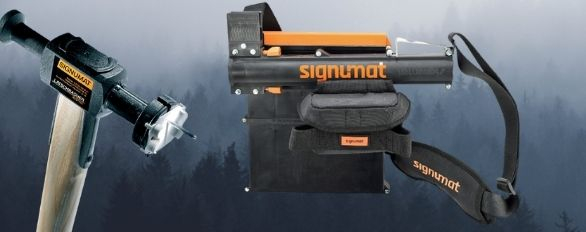
How the ARBOtag system works:
- Insert a ‘stack’ of tags into the spring-loaded magazine.
- Drop a nail into the magnetic nail seat of the hammer.
- Insert the hammer head with nail into the magazine to lodge a numbered tag onto the hammer head.
- Withdraw the hammer head with tag and nail attached, and with one firm strike attach the tag to the tree.
The advantages of this system are numerous – there are many reasons that this system will offer you an effective solution to your tree tagging requirements.
Efficiency – fast application with one strike – on average between 120 and 200 ARBOtags can be fastened per hour. Whilst walking through a woodland, tags can be installed almost without breaking stride.
Effective long term solution – ArboTags are specially designed to ‘grow with the tree’ and the lifespan is enormously increased in comparison to other tags.
Personalisation and professionalism – the tagging system allows for the company name, logo, serial number, or any other required information to be printed onto the tag.
The system also allows integration with other barcode systems that are used within the company, such as a QR code.
Durability – High contrast laser engraving ensures outstanding durability. ARBOtags are recommended to be fixed to the north facing side of the tree, to minimise long term degradation by UV light.
The tags are made from durable plastic (as opposed to shiny aluminium), and don’t attract squirrel theft.
Protection from tag removal or damage – A long-handled hammer is provided which allows the tag to be placed high on the trunk, to reduce the chance of unauthorized removal, especially if the trees are in public places such as parks, as the tags will be way out of reach at between 2.5 and 2.8 metres high.
Suitability for various requirements – Available in packs of 1-200 or in packs of 1000 if needed. Therefore, small, or large quantities available in this system which makes it viable for small and large requirements.
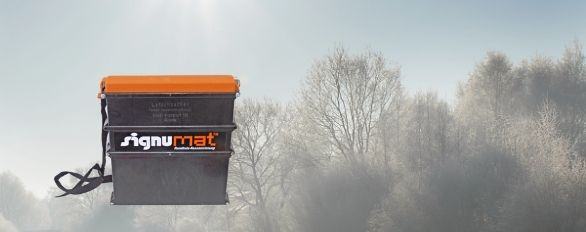
Benefits of the Arbotag system
- The ARBOtag “grows with the tree”, thanks to the star-shaped cutout, which ensures the tag is pushed along the nail as the tree grows (instead of becoming embedded into the tree bark over time, or ‘popping’ off)
- Thanks to the tag moving outwards along the nail with the tree growth, and the high contrast laser engraved number, the ARBOtag will remain highly visible for years to come
- Only the nail enters the tree, ensuring minimal invasion
- Tags have almost unlimited options for customization, allowing not only a name, logo, job, or site identification, but also customised number sequences if required
- UV resistant
- Fast installation
- Tags are held on runners within the magazine or case, ensuring they are always stored and dispensed in numerical order
- Highly durable tagging tools ensure many years of use
- Available in black or white
Limitations of the Arbotag system
- Due to the need to purchase the tagging tools, this system is less cost effective for very low volume or occasional use
- Less flexibility on stock number sequences
Latschbacher Timber Tagging system
The Latschbacher timber tag is used for the identification of felled timber. The tag itself looks similar to the ARBOtag, but with differences in application. The purpose of this tagging option is for the marking and labelling of timber as opposed to living trees and as such each tag is attached by plastic lugs on the back of the tag rather than by a nail. This tag is supplied in two variations – either curved lug tags in white or yellow, or long lug tags in white or yellow. Curved lug tags should be used for end grain timber; long lug tags should be used for fixing into bark. The Timber tag system requires the following:
- A set of tags, available in packs of 1000 numbered 0001-1000, 1001-2000 etc.
- A Signumat Hammer, for use with plastic tags
- A spring-loaded Storage Magazine for storing the tags numerically, with strap for ease of carrying, and storage case.
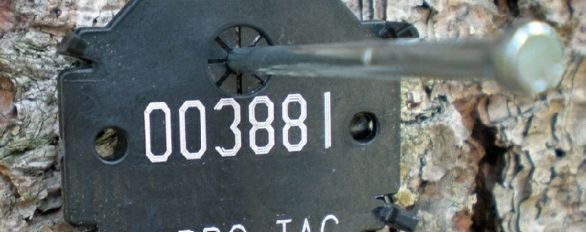
How the Latschbacher timber tagging system works:
- Insert a ‘stack’ of tags into the spring-loaded magazine.
- Insert the hammer head with nail into the magazine and one firm press will lodge a numbered tag onto the hammer head.
- Withdraw the hammer head with tag attached, and with a firm strike attach the tag to the tree. The barbed lugs will ‘bite’ into the timber for a very secure fix
Latschbacher timber tags are a great solution for labelling up timber stocks. Here’s why.
Durable – Made from very tough plastic with strong integrated lugs on the backs, so there is no need for nails (although a nail may be required if attaching to very thick bark).
Quick and easy to install – You can mark a large amount of timber very quickly. This system saves on time, allowing for excellent efficiency and overall cost effectiveness, reducing labour costs.
Personalisation – Latschbacher Timber tags allow for specific requirements such as the company name, serial number, logo etc. to be printed onto the tag. The system allows integration with other barcode and QR systems that are used throughout the company.
Adaptable – Latschbacher Timber tags offer two types of tags for different requirements – Long lug tags for fixing into bark and curved tags for end grain timber.
Benefits of the Latschbacher timber tagging system
- The integral lugs on the tag attach securely to the timber and the tag cannot easily be removed
- Tags have almost unlimited options for customization, allowing not only a name, logo, job or site identification, but also customised number sequences if required
- UV resistant
- Fast installation
- Tags are held on runners within the magazine or case, ensuring they are always stored and dispensed in numerical order
- Highly durable tagging tools ensure many years of use
- Available in yellow or white from stock; other colours and shapes of tag are available to special order
Limitations of Latschbacher timber tag system
- Due to the need to purchase the tagging tools, this system is less cost effective for very low volume or occasional use
- Not designed for tagging live trees (for this, we recommend the Arbotag system).
Latschbacher Galvanised tagging system
Latschbacher’s galvanised tags were originally designed for number posts and poles. However, these can also be used for various other purposes including end grain cut timber.
Very similar in principle to the ‘timber tags’ with curved lugs, the galvanised tags are dispensed from the magazine in numerical order, but are used with a magnetic hammer which clings to the tag and then attaches it to the timber using the inbuilt prongs on the back of the tag. The embossed numbers are not subject to fading.
We stock galvanised tags in a selection of standard numbering sequences, 0001-1000 etc. There are also limited customisation options to special order – text can be added, or specific alpha-numerics. Please enquire for more details.
Tree marking the colourful way
We also offer other options for tree or timber marking, for when you require clear identification of trees that need to be felled, trees that need work carrying out, or for cordoning off an area.

Distein offer intense, neon colours, that can be sprayed onto the tree or timber. The ‘writing spray’ nozzle allows neat and precise marking. The paints are weatherproof, can withstand extreme temperatures and are environmentally friendly.
Designed for marking timber, we offer special crayons that are weatherproof and colour intense. They are available in blue, red, and yellow.
Tree tape is ideal for temporarily marking or identifying specific trees. It comes in 20mm wide x 70 metre rolls and is stocked in red, yellow, and blue.
We hope that this blog has assisted in the explanation of different tree tagging options and their suitability to your specific requirements. Please do not hesitate to call our office and speak to one of our friendly staff if you’d like to discuss your requirements.

